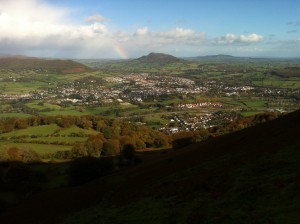There’s the wreck of a Soviet submarine on the Medway near Rochester – and, in the BBC’s 1966 drama documentary ‘The War Game’ Rochester is one of the targets of a nuclear bomb. But it wasn’t a Soviet submarine, nor a bomb that destroyed the city of Rochester – this was achieved by a council oversight in 1998, when, during local government reorganisation, the city, accidentally, was abolished. That is, Rochester lost its city status. Rochester is now just a town.
Rochester has a magnificent Norman castle, it towers into the clouds. Next to the castle is a beautiful cathedral. There’s a pleasant town centre, numerous Charles Dickens themed businesses: a gift shop, ‘Sweet Expectations’, there’s ‘Little Dorritt’, (which describes itself as a metaphysical supply shop) ‘Jaggers Tapas Bar’, ‘Oliver’s’ – a restaurant, and a fresh fruit and veg place called ‘Food Glorious Food’. While the names of these businesses come straight out of Dickens, nearby place names could be lifted from Lord of the Rings: Strood, Snodland, the Hoo peninsular.
Charles Dickens spent his early years in nearby Chatham, and, in his later years, returned to live in nearby Higham. Restoration House in Rochester became the model for Miss Havisham’s house in Great Expectations. In that novel Dickens renamed it Satis House, taking the name from another building in Rochester. And maybe the name Havisham is a reworking of Faversham, a town just a few miles away. JK Rowling named Harry Potter’s stuffy relatives the Dursleys after the town of Dursley in Gloucestershire, close to where she grew up. So let’s imagine Charlotte Bronte came up with Mr Rochester after the city that is now a town. I like to imagine Dickens wandering the Rochester, staring at buildings, his imagination working and reworking reality into his stories. One building becomes another, one name another, shapes shift, faces appear in the clouds, Magwich leaps out from behind gravestone in a foggy cemetery, and the fog, yes the fog – read the first page of Bleak House, the word fog appears ten times and more, fog on the Medway, fog on the Kent coast, this is the fog of the imagination shapeshifting faces and figures, place names, buildings.
Do you want fog or facts? Facts says Mr Gradgrind in Hard Times, now what I want is facts. Well, let’s not bother too much with Mr Gradgrind, even if he would approve of the UK’s tired examination system. Here are some Dickens facts: born in Portsmouth 1812, and he died 1870, in Higham, a few miles outside of Rochester. 1812, the year the USA declared war on Britain, Spencer Perceval, the British Prime Minister, was assassinated. From the ages of four to eleven, Dickens lived in Chatham, just down the road from Rochester. Here his childhood mind, emerging from the fog of infancy, differentiated one thing from another, the docks, the bridges, the river, place names, people, faces.
Dickens’ novels expose the harsh conditions of life during the early years of the industrial revolution in England. Oliver Twist describes the horror of workhouses, Nicholas Nickleby the exploitation of workers and Bleak House the inequities of the justice system. He uses the fog of his imagination to explore the facts of the world. Just a walk from Rochester town centre is the village of Borstal, a name which, in the UK, was once synonymous with youth detention centres. The system was abolished in 1982, exactly 80 years after its creation. Although Borstals had a reputation for tough discipline its origins were enlightened – aiming not to punish the young, but to rehabilitate. Borstal schools still exist in India, despite their abolition in the UK. I walked from Snodland to Birling, the footpath circumnavigating a vast Tesco distribution centre. From Birling it was a just a short distance to Coldrum Long barrow, somewhere around six thousand years old, early neolithic, or new stone age, just before the dawn of agriculture. In Rochester, the next day, I found the Man O’Kent, a pub not far from the centre of town. There was a music session going on, participants took it in turns to sing, or lead. I was there just to observe, but was asked if I wanted to sing, so I did. It was a wonderful evening. I found it a very friendly place, which, despite being a town that was once a city, didn’t seem to harbour any grudges. All that it harboured was the rusty old Soviet submarine.
(This is a transcription from my podcast ‘These Weird Isles’, available on most platforms.)
